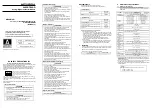GP = LFL as before we can see the result in Figure 21.
Figure 21: Solid curve - graph of GF needed
for constant energy ratios with new center
attenuation GC. Dashed curve is
sin(cs)*corr1 (the previous LFR element).
Dotted curve is sin(cs). Note that GF is close
to zero until cs reaches 30 degrees, and then
increases sharply. In a practical decoder we
arbitrarily increase
the value of GF after 30 degrees to end up at
the value of 0.71 like the two other curves.
This causes complete cancellation of the
center channel from the left and right during
strong steering. Also GF needs to smoothly
interpolate to the previous value along the
boundaries. In practice all these curves have
a negative sign.
GF gives the shape of the LFR matrix element along the lr=0 axis, as cs increases from
zero to center. We need a method of blending this behavior to that of the previous LFR
element, which must be preserved along the boundary between left and center, as well as
from right to center. A method of doing this when cs <= 22.5 degrees is to define a
difference function between GF and sin(cs). We then limit this function in various ways.
gf_diff = sin(cs) – gf(cs);
for cs = 0:45;
if (gf_diff(cs) > sin(cs))
gf_diff(cs) = sin(cs);
end
if (gf_diff(cs) < 0)
gf_diff(cs) = 0;
end
end
% find the bounded c/s
if (y < 24)


















